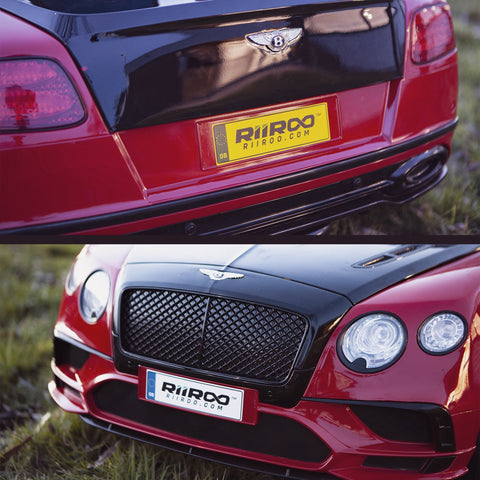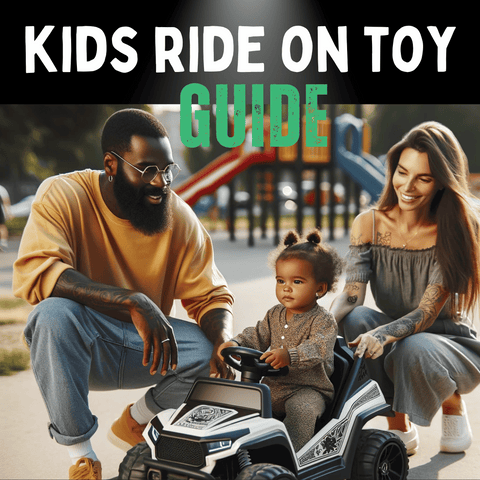
Updated: 13.6.24
Choosing the right ride-on car for your child isn't just about fun and games.
It's about finding a balance between safety, engagement, and development.
As a parent, guardian, or educator, you're tasked with picking a toy that not only brings joy but also contributes positively to their growth.
So, what exactly should you look out for to ensure you're making the best choice for your little one?
Safety Features
Safety First Ensuring your child's safety is paramount. Look for ride-on cars equipped with seat belts, speed limiters, and, importantly, parental remote control.
These features offer peace of mind, knowing that you can oversee your child’s playtime and intervene when necessary.
After all, isn't it better to be safe than sorry?
Related: 10 Things I Wish I Knew Before Buying A Kids Electric Ride On Car
Size and Weight Considerations
Getting the Size Right Just like clothing, ride-on cars need to fit your child perfectly.
It's crucial to select a car that aligns with your child's age, height, and weight.
This isn't just about comfort; it's about safety. An oversized or undersized ride-on car can pose risks, so always check the manufacturer's guidelines.
Related: Kids Ride on Toy Buyers Guide
Battery Life and Power
The Power Behind the Fun Battery life is a key factor in uninterrupted play.
Opt for a car with a long-lasting battery, preferably one that offers at least an hour of continuous use.
| Battery Type | Average Charging Time | Weight | Lifespan |
|---|---|---|---|
| Lead-Acid | 8-12 hours | Heavier | Shorter |
| Lithium-Ion | 3-6 hours | Lighter | Longer |
This aspect can significantly impact how often your child enjoys their ride-on car and for how long.
Motor Specifications
Single vs Dual Motor: What's Best for Your Child? Your choice here depends on your child's weight and the desired performance.
Dual motor ride-on cars offer steadier rides for heavier children, while single motor cars are suitable for lighter weights.
However, both can provide similar speeds, so weigh your options based on your child's specifics.
| Motor Type | Best for Weight Range | Performance | Ideal Usage |
|---|---|---|---|
| Single Motor | Up to 50 lbs | Moderate | Flat Surfaces |
| Dual Motor | 50 lbs and above | High | Varied Terrain |
Design and Build Quality
Quality that Lasts A ride-on car isn't just a toy; it's an investment.
You want something that can withstand the test of time and play.
Pay attention to the design - does it emulate a real car? Is it built to last? These considerations ensure you get the best value for your money.
Comfort Features
Comfort is Key No child wants to ride in discomfort.
Choose a car with soft, cushioned seats, especially if you're opting for a model with longer battery life.
Remember, the more comfortable the ride, the longer they'll play.
Type and Model Selection
A Car that Reflects Their Personality Ride-on cars come in all shapes and sizes, from sports cars to construction trucks.
Think about what excites your child.
Do they dream of being a police officer or a race car driver?
Matching the car to their interests can make a world of difference in their play.
| Model Type | Recommended Age | Key Features | Ideal For |
|---|---|---|---|
| Super Cars | 3-6 years | Sleek design, high speed | Racing enthusiasts |
| Police Cars | 3-6 years | Flashing lights, siren sounds | Role-playing |
| Construction Trucks | 3-6 years | Realistic design, functional parts | Construction play |
| ATVs | 3-8 years | Rugged build, off-road capabilities | Outdoor adventures |

Customer Reviews and Feedback
Learning from Others One of the best ways to gauge a ride-on car's performance and reliability is through reviews from other parents.
Their experiences can provide valuable insights into the specific make or model you're considering.
Budget Considerations
Balancing Cost and Quality Ride-on cars come in a wide price range.
It's essential to find a balance between what you can afford and the features that are important for your child's enjoyment and safety.
Remember, the most expensive option isn't always the best one.
Types of Ride-On Cars
Exploring the Options
- Push/Pull Ride-Ons: Ideal for babies and toddlers, these require adult assistance.
- Ride-Ons with Steering Controls and Pedals: Perfect for kids ready to take control.
- Electronic Ride-Ons: A modern choice offering a range of models like Lamborghini and BMW.
- ATV Ride-Ons: For the adventurous child, offering a more rugged experience.
- UTVs: Single-seat options with chunky tyres, great for rougher terrain.
- Kids Drift Cars: Designed for thrilling drifts and turns.
- Motorcycles: Tailored for toddlers with added safety features like training wheels.
| Type of Ride-On Car | Ideal Age Range | Power Source | Best Use Environment |
|---|---|---|---|
| Push/Pull Ride-Ons | 1-3 years | Manual | Indoors/Outdoors (Flat Surfaces) |
| Electronic Ride-Ons | 3-8 years | Battery-Powered | Outdoors |
| ATV Ride-Ons | 4-9+ years | Battery-Powered/Manual | Outdoors (Rough Terrain) |
| UTVs | 5-9+ years | Battery-Powered | Outdoors (Varied Terrain) |
| Kids Drift Cars | 3-9 years | Battery-Powered | Outdoors (Flat, Paved Surfaces) |
| Motorcycles (with Training Wheels) | 3-7 years | Battery-Powered | Indoors/Outdoors (Flat Surfaces) |
By understanding these types and their unique features, you can make an informed decision that aligns with your child's age, interests, and your safety concerns.
Related: How Do I Transition My Child From an Electric Ride on to Petrol?
Understanding Battery Types and Charging Requirements
When selecting a ride on car, especially a battery-powered car, it's essential to understand the battery size and charging requirements.
Ride-on cars typically come with 6V batteries, 12V batteries, or 24V options.
Battery charging times vary; for instance, a 12V battery might take less time to charge than a 24V battery.
It's crucial to balance battery lifespan with daily usage needs, ensuring your child enjoys their electric toy car without frequent interruptions for charging.
Battery Options: Lead-Acid vs Lithium-Ion
When it comes to ride-on cars, the two main types of batteries you'll encounter are lead-acid and lithium-ion.
Lead-acid batteries, often found in traditional models, are heavier and have a longer charging time but are usually more cost-effective.
Lithium-ion batteries, on the other hand, are lighter, charge faster, and typically last longer, making them a great choice for more advanced models.
Understanding the type of battery in the ride-on car can help you manage expectations regarding performance and charging time.
Charging Time and Practices
Charging times can vary significantly between models.
Generally, lead-acid batteries may take 8-12 hours to fully charge, while lithium-ion batteries can charge in 3-6 hours.
It's important to follow the manufacturer's instructions to ensure battery longevity.
Overcharging can reduce the battery life, so using a timer or charging overnight might not always be the best approach.
Also, consider the practicality of charging: will the car need to be near a power source, or can the battery be removed for charging?
Maintenance Tips for Longevity
Regular Cleaning and Inspection
Regular cleaning and inspection are vital for both licensed and unlicensed models of ride-on cars.
Maintaining these cars properly is essential for longevity.
Check components like the wheels and steering wheel as part of your routine maintenance.
Proper Storage
Proper storage is key in maintaining your ride-on car, especially when considering indoor and outdoor use.
Store the car in a space that is free from extreme temperatures and moisture to prevent damage to the battery and the car's bodywork.
Battery Care
Battery care is critical for ensuring a long battery lifespan.
For ride on cars with lead-acid batteries, regular charging is crucial, even during periods of non-use, to maintain battery health.
In contrast, lithium-ion batteries used in some models require different care, such as avoiding complete discharge before recharging.
Check the Tyres Regularly Just like a real car, the tyres on a ride-on car can wear down over time.
Regularly check them for signs of wear and tear and ensure they are properly inflated (if applicable).
This not only ensures a smoother ride but also prevents accidents caused by tyre failure.
Conclusion
Whether you're choosing a dual motor 12V ride on car or a single motor model, understanding and maintaining the battery and the car's overall condition is essential.
Paying attention to battery size, charging times, and proper maintenance practices will ensure your child enjoys their electric toy car for years to come, while adhering to safety guidelines and ensuring age appropriateness.
Remember, investing a bit of time in maintenance can significantly extend the life and performance of your child's cherished ride-on car.
Frequently Asked Questions (FAQs)
What is the ideal age range for kids to start using ride-on cars?
The ideal age for kids to start using ride-on cars typically begins from as young as 1 year old, with push-along cars suitable for toddlers. As children grow, around ages 3 to 8, they can transition to more advanced battery-powered or pedal cars, depending on their motor skills and interest level. It’s important to choose a ride-on car that aligns with the child's developmental stage for both safety and enjoyment.
Can ride-on cars be used indoors, or are they only suitable for outdoor play?
Many ride-on cars are versatile enough to be used both indoors and outdoors. However, the suitability depends on the size of the car and the available space. Smaller, manual push-along cars are often ideal for indoor use, while larger, battery-powered models are better suited for outdoor spaces. Always ensure there is ample safe space for your child to play without risks of accidents or damage to home furnishings.
How do I choose between a manual (pedal) and an electric ride-on car for my child?
The choice between a manual (pedal) and an electric ride-on car depends on your child's age, physical abilities, and interests. Manual cars are great for younger children as they help develop motor skills and require physical activity. Electric cars, on the other hand, are more suitable for older children who can handle more complex controls and are looking for a more realistic driving experience. Consider your child's readiness for either type in terms of coordination and safety awareness.
Are there any special considerations for maintenance and care during colder months or winter?
Yes, during colder months or winter, special care should be taken, especially for electric ride-on cars. It's advisable to store the car in a dry, cool place to protect the battery and electronic components from extreme cold, which can reduce battery efficiency and lifespan. If the ride-on car won’t be used for an extended period, fully charge and disconnect the battery before storing. Additionally, check for any necessary maintenance or repairs before storing, so it’s ready for use when the weather improves.
Get in Touch 🚀
Loved our article on “Things to Look for When Buying a Kids Ride on Car” Got the itch to dive into more wheely-awesome info?
Whether you're a parent or a grandparent, we're here for all your kids ride-on toy questions! 🚗💨
Feeling click-happy?
Jump straight into our wonderland at RiiRoo.com.
Or, if you're more the chatty type, give our Live Chat a whirl and let's talk toys!








Share:
Here's What Safety Gear Dirt Bike Riders Need For Max Safety
Petrol or Electric? Which Dirt Bike is Better For You?